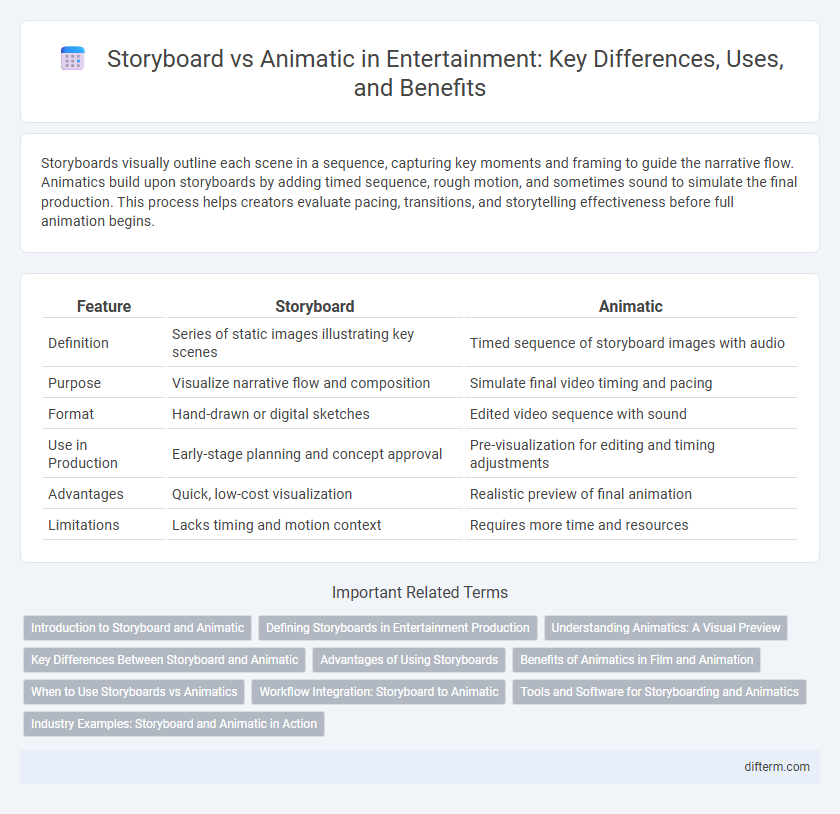Storyboards visually outline each scene in a sequence, capturing key moments and framing to guide the narrative flow. Animatics build upon storyboards by adding timed sequence, rough motion, and sometimes sound to simulate the final production. This process helps creators evaluate pacing, transitions, and storytelling effectiveness before full animation begins.
Table of Comparison
| Feature | Storyboard | Animatic |
|---|---|---|
| Definition | Series of static images illustrating key scenes | Timed sequence of storyboard images with audio |
| Purpose | Visualize narrative flow and composition | Simulate final video timing and pacing |
| Format | Hand-drawn or digital sketches | Edited video sequence with sound |
| Use in Production | Early-stage planning and concept approval | Pre-visualization for editing and timing adjustments |
| Advantages | Quick, low-cost visualization | Realistic preview of final animation |
| Limitations | Lacks timing and motion context | Requires more time and resources |
Introduction to Storyboard and Animatic
A storyboard is a sequence of illustrated frames that visually represents the script and key scenes of a film or animation, serving as a blueprint for production. An animatic is a preliminary version of the film created by editing storyboard images with timing, sound, and motion to simulate the final product. Both tools are essential in the entertainment industry for planning visual storytelling and ensuring smooth workflow during development.
Defining Storyboards in Entertainment Production
Storyboards in entertainment production serve as visual blueprints, outlining key scenes, character actions, and camera angles to guide the creative process. They provide a static sequence of drawings that convey narrative flow and composition before animation or filming begins. By establishing timing and spatial relationships, storyboards enable directors, animators, and producers to visualize story structure and plan efficient scene execution.
Understanding Animatics: A Visual Preview
Animatics serve as a crucial step between storyboards and final animations, providing a timed, rough version of scenes that integrates basic motion and audio cues. They offer directors and animators a visual preview to evaluate pacing, camera angles, and story flow before full production begins. This process helps identify potential issues early, saving time and resources by refining the narrative structure efficiently.
Key Differences Between Storyboard and Animatic
Storyboards are static visual sequences that outline key scenes and camera angles, serving as the blueprint for the entire production. Animatics compile these storyboard images with timed audio and rough motion, providing a preliminary visual flow and pacing of the final animation. The primary difference lies in their function: storyboards establish the narrative structure, while animatics simulate the timing and rhythm of the completed project.
Advantages of Using Storyboards
Storyboards offer a clear visual outline of a scene's narrative and composition, enabling filmmakers to plan shots efficiently and communicate ideas effectively with the production team. They allow for early identification of potential issues in pacing, continuity, and framing before costly filming begins. Using storyboards reduces time and budget overruns by providing a detailed blueprint that guides the entire creative process from pre-production to post-production.
Benefits of Animatics in Film and Animation
Animatics enhance film and animation production by providing a dynamic visualization of scenes that helps identify pacing, timing, and transitions before costly full-scale production begins. They facilitate clearer communication between directors, animators, and editors, reducing misunderstandings and streamlining workflows. This early-stage feedback mechanism significantly cuts down production time and budget by allowing precise adjustments to narrative flow and visual continuity.
When to Use Storyboards vs Animatics
Storyboards are essential during the pre-visualization phase to establish composition, camera angles, and narrative flow, providing a static yet detailed blueprint of a project. Animatics are most effective when timing, pacing, and motion need to be tested, offering a dynamic preview that simulates the final animation or film sequence. Use storyboards for initial conceptualization and animatics for refining the timing and rhythm before full production begins.
Workflow Integration: Storyboard to Animatic
The workflow integration from storyboard to animatic streamlines pre-production by transforming static sketches into timed sequences with motion and sound cues. Storyboards establish the visual narrative and composition, while animatics refine pacing and camera movements, improving communication among directors, animators, and editors. This seamless transition enhances project efficiency, reduces revisions, and ensures alignment with the creative vision before full animation begins.
Tools and Software for Storyboarding and Animatics
Storyboarding utilizes tools like Storyboard Pro, Photoshop, and Toon Boom to create detailed frames and visual narratives, while animatics rely on software such as Adobe Premiere Pro, After Effects, and Final Cut Pro to produce timed sequences with sound and motion. Storyboard Pro integrates both drawing and timeline features, making it a popular choice for transitioning from static storyboards to animatics seamlessly. Using dedicated animatic software enhances feedback and revision processes by allowing creators to sync audio, adjust timing, and simulate the pacing of the final animation.
Industry Examples: Storyboard and Animatic in Action
Pixar's production of "Toy Story" demonstrates the vital role of storyboards in visualizing complex scenes before animation begins, ensuring narrative coherence and effective pacing. Warner Bros. employs animatics extensively in the "Looney Tunes" series, allowing directors to refine timing and sound synchronization prior to full animation. These industry examples highlight how storyboards and animatics serve as essential tools to streamline creative workflows and enhance storytelling quality in cinematic projects.
storyboard vs animatic Infographic

 difterm.com
difterm.com